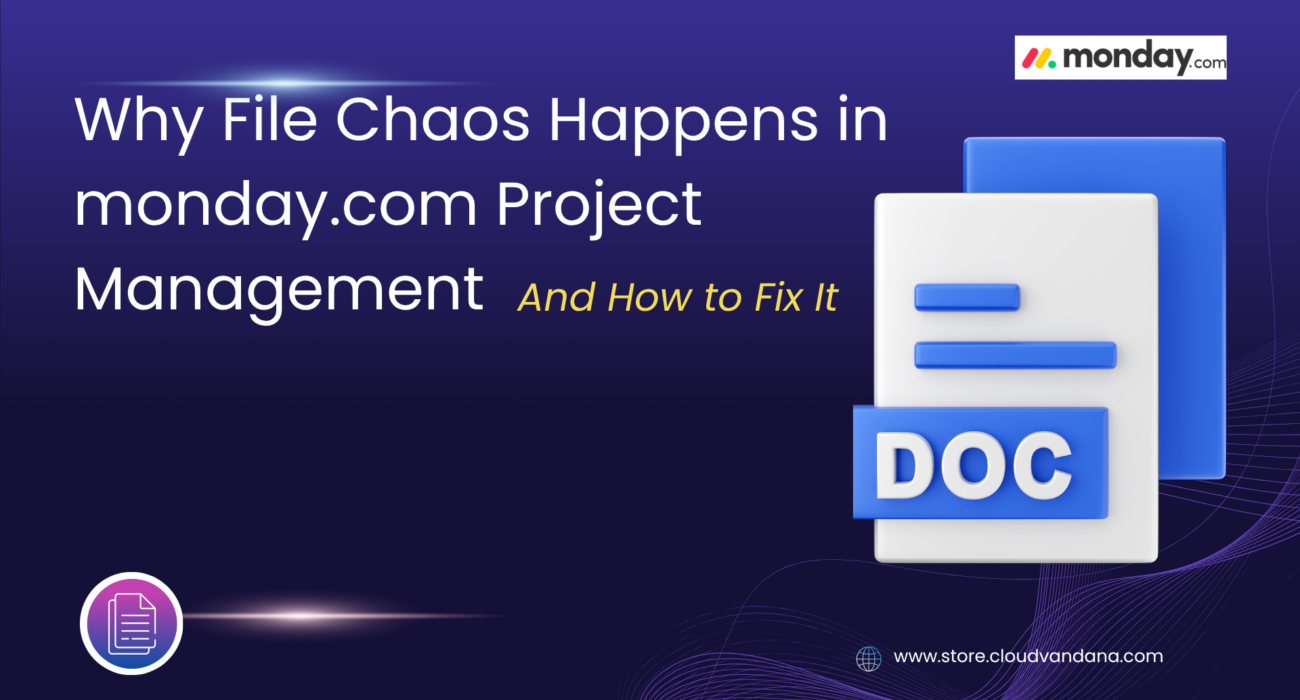- monday Project Management
- Understanding Project Management in monday.com
- Why Popular Project Management Tools Fall Short on File Handling
- Everyday File Chaos: What It Looks Like in Real Life
- Identifying Causes of File Chaos
- The Ripple Effects of File Disarray
- Best Practices to Bring Structure to File Management
- The Rise of File Flow Automation
- Best Practices for Effective Project Management
- Want to Take It Further? Enter: Copy Files Pro
- FAQs on File Chaos in Project Tools
Why File Chaos Happens in monday.com Project Management—and How to Fix It
Struggling with disorganized files in monday project management? Learn why file chaos happens, how it affects productivity, and what you can do to structure and automate your workflows for better collaboration and control.
monday Project Management
When Storage Isn’t the Issue—But Structure Is
Most project teams don’t realize they’re not drowning in too many files—they’re drowning in unstructured files.
It’s easy to blame storage limits, lack of drive space, or platform quirks. But in reality, the culprit behind file chaos in project management tools is a breakdown in structure.
Modern platforms like monday.com give you robust task boards, beautiful dashboards, and collaboration superpowers. But when it comes to managing documentation—versioned files, supporting assets, cross-team references—things often spiral out of control.
And that’s where the chaos begins.
Disconnected boards. Misaligned file versions. Important attachments hiding in update threads. Multiple copies of the same file floating across items and columns. A dozen “final” versions, none of them truly final.
Every minute spent searching for the right file is a minute not spent moving the project forward.
This problem is not about more storage.
It’s about smarter structure.
Understanding Project Management in monday.com
monday.com provides a robust work os environment designed to simplify project execution and improve team performance. As a SaaS management tool, it enables project managers to assign tasks, set deadlines, and track progress in real-time. Understanding the core functionalities of monday.com is crucial to effectively manage project details.
By utilizing monday.com as a central hub, project teams can collaborate seamlessly, sharing files and updates within the platform. This integration promotes transparency and minimizes the risk of miscommunication, leading to better outcomes in project development.
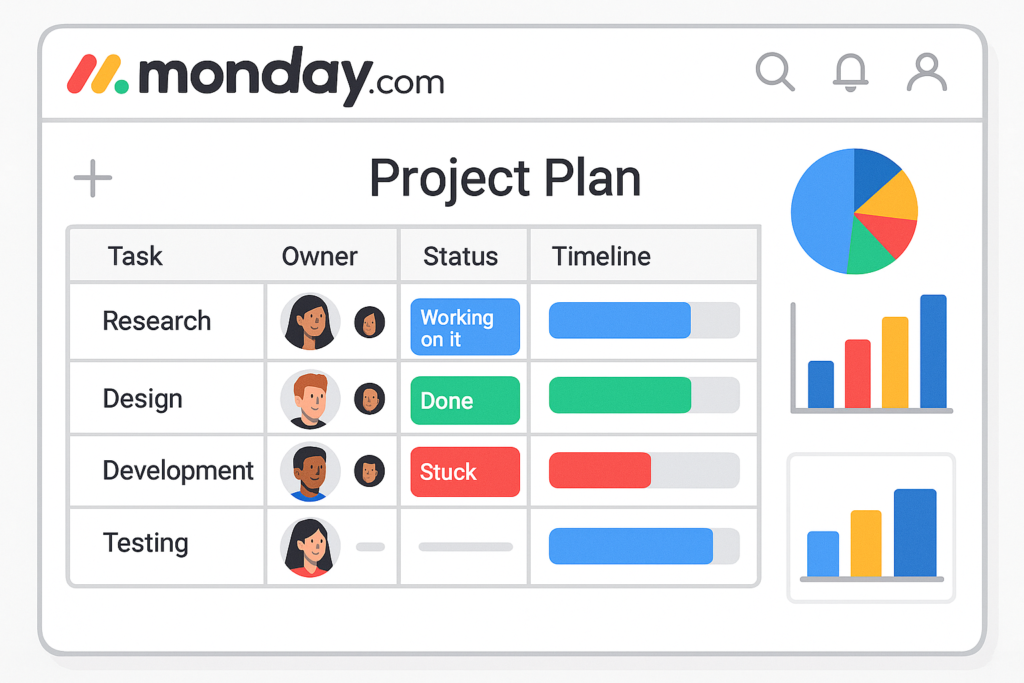
The Importance of a Clear Project Plan
A well-defined project plan is the cornerstone of effective project management. In monday.com, this translates to setting clear project goals, outlining the project scope, and establishing dependencies between tasks. A robust project plan ensures that every team member understands their responsibilities and the timeline for completion.
Failing to create a comprehensive project plan can lead to confusion, missed deadlines, and ultimately, file chaos. Templates within monday.com can serve as a starting point, but customizing them to reflect the unique requirements of each project is essential. The project plan should clearly define how files are to be named, stored, and accessed, minimizing ambiguity and promoting consistency throughout the project lifecycle. When starting with a development project, make sure to have a clearly defined project plan.
Common Workflow Challenges
Several common workflow challenges can contribute to file chaos in monday.com. Inconsistent file naming conventions make it difficult to locate specific document. Another challenge arises from a lack of clear folder structures, leading to files being scattered across different boards and workspaces.
Inadequate version control can also result in confusion, especially when multiple team members are collaborating on the same document. Furthermore, failure to regularly update the status of tasks and deliverables can create discrepancies between the information in monday.com and the actual project progress.
These challenges can be overcome by implementing standardized procedures and ensuring that all stakeholders adhere to them.
Utilizing Dashboards for Better Management
monday.com’s dashboards offer a powerful way to visualize project data and monitor team performance. Project managers can leverage dashboards to track progress against deadlines, identify potential bottlenecks, and gain insights into resource management.
A well-designed dashboard can provide a real-time overview of the project’s status, including the number of completed tasks, upcoming deadlines, and potential risks. Moreover, dashboards can be customized to display file-related information, such as the number of files uploaded, the total file size, and the frequency of file updates.
By regularly reviewing dashboards, project managers can proactively identify and address file management issues, ensuring that the project stays on track and that all deliverables are readily accessible. These dashboards will provide project updates, improving transparency and streamlining business operations. A good dashboard helps a marketer follow the evolution of a project.
Why Popular Project Management Tools Fall Short on File Handling
Let’s start by acknowledging that monday.com and similar platforms do an excellent job of visualizing tasks. You get color-coded status updates, owner assignments, dependencies, and even timelines that let you zoom out and see the big picture.
But the moment your project gets document-heavy—think design assets, proposals, briefs, contracts, or stakeholder reviews—you begin to see the cracks.
Here’s why:
- Files attach to places, not processes: A file added to an update stays buried there. A document added to a column may not show up when the item is duplicated. There’s no continuity.
- Duplication doesn’t mean duplication of files: When you duplicate an item or board to replicate a workflow, the files don’t come along for the ride—at least not automatically.
- Lack of native file versioning: monday.com doesn’t version files like Google Docs or Dropbox. Uploading a new file doesn’t overwrite the old one—it just adds another file to the pile.
- Scattered file locations: Files can be attached to updates, columns, or file columns. With no enforced structure, teams default to convenience—which means documentation ends up everywhere.
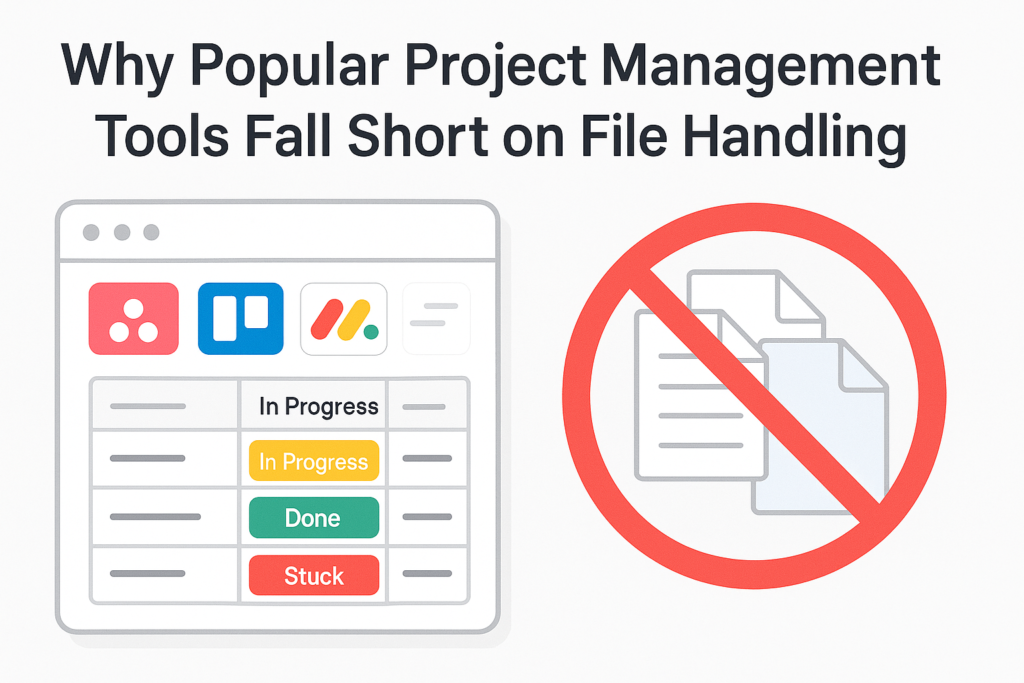
This creates an environment where documentation is fragmented, hard to trust, and even harder to maintain.
Everyday File Chaos: What It Looks Like in Real Life
Let’s zoom in on a few everyday project scenarios that reveal how file chaos creeps in:
Use Case 1: The Marketing Launch Maze
A marketing team is preparing for a product launch. The campaign includes:
- Landing page copy
- Social media assets
- Ad creatives
- Sales enablement decks
Each of these elements lives in a monday.com board. A social media manager attaches the ad copy to an update. The designer uploads the Figma link into a file column. The campaign lead pastes the Google Doc into the item description.
Mid-week, the campaign board is duplicated for the next product line.
But none of the assets move. The new board is blank. Now, people are pinging each other: “Hey, where’s the final creative?” “Which version are we using for paid ads?”
Chaos.
Use Case 2: The Agency-Client Tug of War
A creative agency manages multiple clients through separate monday.com boards. Each client board holds tasks, deliverables, and meeting notes.
During client reviews, the project manager often duplicates tasks to a shared “Client Review” board.
The problem? Files attached to internal boards don’t move with the task. So when the client opens their review board, they see task names but no deliverables.
Confusion. Follow-ups. Delays.
Use Case 3: Cross-Team Collaboration Breakdown
The product, design, and engineering teams are collaborating on a new feature.
The product spec is attached to the item as a file. The design mocks are uploaded to the design column. Engineering adds API documentation to an update.
When the item is duplicated into the sprint board, only the task structure copies over.
No specs. No mocks. No docs.
And now, engineers are working blind.
Identifying Causes of File Chaos
Lack of Communication and Collaboration
One of the primary culprits behind file chaos in any work management system, including monday.com, is a breakdown in communication and collaboration among team members. Without clear lines of communication, misunderstandings can arise regarding file naming conventions, storage locations, and version control. This is amplified in a project development environment.
If team members are unaware of where to find specific files or which version is the most current, valuable time is wasted searching for information, ultimately hindering productivity. Proper integration and communication are critical for streamlining workflow. To combat this, project managers must establish clear communication channels and protocols, ensuring that all stakeholders are on the same page when it comes to project details and file management practices.
This includes regular status updates, team meetings, and the use of monday.com’s built-in communication features to facilitate seamless collaboration and information sharing. Utilizing project management software effectively requires a strong emphasis on fostering open and transparent communication to prevent file chaos.
Inadequate Risk Management Strategies
Another contributing factor to file chaos is the lack of robust risk management strategies in place. Project management inherently involves potential risks, including data loss, file corruption, and security breaches. Without proactive measures to mitigate these risks, project teams can find themselves scrambling to recover lost or damaged files, disrupting the project timeline and causing significant setbacks.
Project managers should implement comprehensive risk management strategies that include regular data backups, secure file storage practices, and access controls to protect sensitive project information. By anticipating potential risks and implementing safeguards, teams can minimize the likelihood of file-related incidents and ensure the continuity of project operations. monday.com can be configured to offer automated reminders for backups and security checks, enhancing your overall approach to project management and providing peace of mind to project managers and team members. Use monday service to plan your risk management.
Issues with Remote Work Coordination
The rise of remote work has introduced new challenges to project management, particularly when it comes to coordinating file management across geographically dispersed teams. When team members are working from different locations and time zones, it can be more difficult to maintain consistency in file naming, storage, and version control. This is particularly true with development projects that require project details to be clearly laid out. Inadequate communication and collaboration tools can exacerbate these challenges, leading to confusion and disorganization.
To address these issues, project managers need to establish clear guidelines for remote work coordination, ensuring that all team members have access to the necessary tools and resources to manage files effectively. monday.com’s collaborative features, such as shared workspaces and real-time document editing, can help bridge the gap between remote team members, fostering better communication and coordination.
By leveraging these features, project teams can maintain a cohesive approach to project management, regardless of their physical location. Efficiently managing remote workers through project management platforms also ensures that all deliverables meet the project goals.
The Ripple Effects of File Disarray
File chaos doesn’t just slow things down. It quietly corrodes collaboration and confidence.
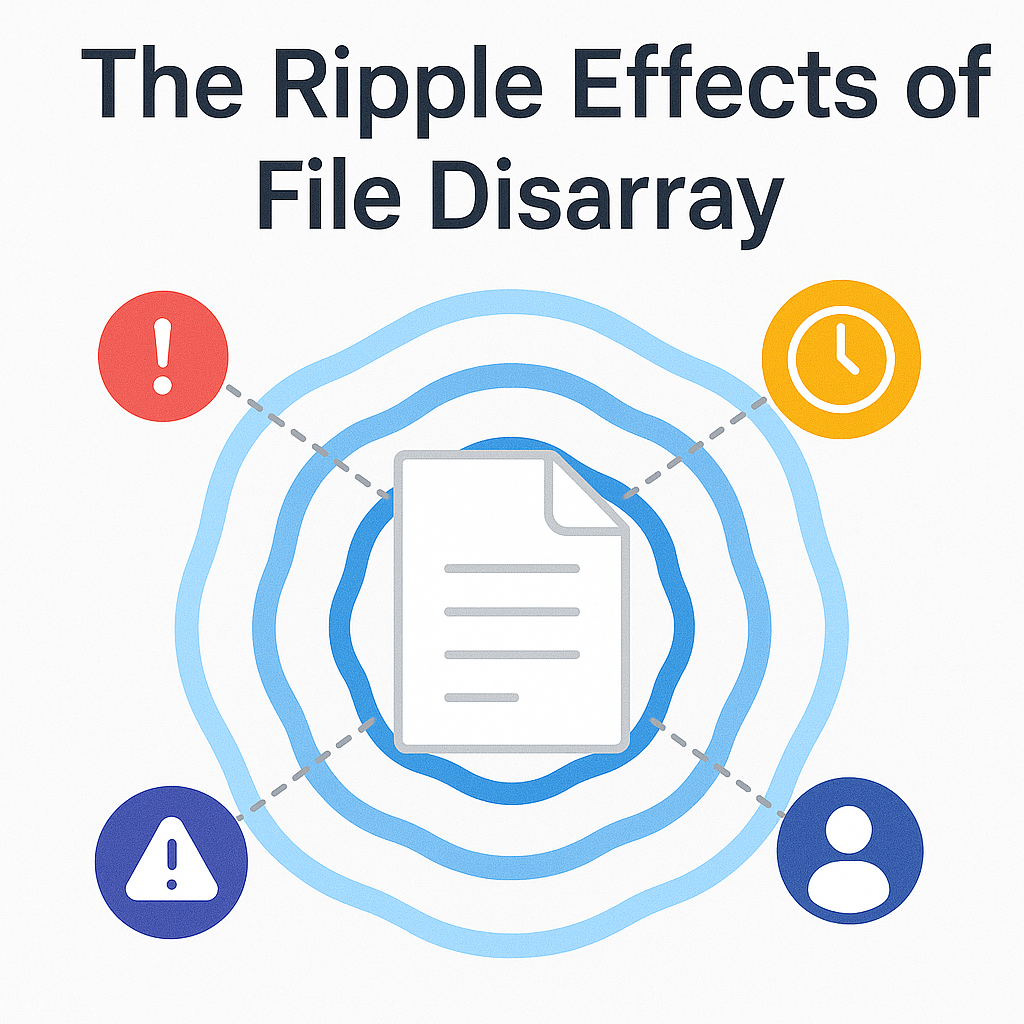
Productivity Loss
Knowledge workers spend nearly 20% of their time searching for internal information. That’s one full workday per week wasted on file-hunting.
Imagine the cost when your designer is scouring Slack for the right mockup or your PM is digging through six boards to find last month’s feedback.
Versioning Confusion
When multiple versions of a document exist in multiple locations, teams start making decisions based on outdated information.
Version 3 gets presented to leadership while the team has already moved on to Version 5.
It’s not just embarrassing. It’s risky.
Decision-Making Bottlenecks
When files aren’t readily accessible, decisions stall. Feedback loops lengthen. And trust in the system erodes.
People resort to email attachments, screenshots, or worse—manual rework.
Best Practices to Bring Structure to File Management
Here’s the good news: File chaos is preventable.
With the right structural approach, teams can keep their documentation clean, accessible, and trustworthy—without babysitting every file.
1. Establish File Naming Conventions
Create consistent, descriptive file names that help anyone understand what the file is—without opening it.
Examples:
- ProjectX_CampaignBrief_v1.pdf
- ClientName_Q3ReviewDeck_FINAL.pptx
- OnboardingChecklist_TeamOps_2025.xlsx
Include date stamps or version numbers if needed. Avoid spaces and cryptic abbreviations.
2. Define Where Files Live
Decide as a team:
- Should all documentation live in a file column?
- Should links to cloud storage live in text columns or updates?
- Where do final files go?
Make the rule. Stick to it.
3. Use Cloud Storage Integrations Strategically
Rather than uploading new versions constantly, link to cloud files—Google Drive, Dropbox, OneDrive—so that everyone always sees the latest document.
A single link, always up to date.
4. Make File Movement Part of Task Movement
When tasks move across phases or boards, make sure their files follow. If your tool doesn’t support this natively, use automation or third-party apps to bridge the gap.
A file shouldn’t get left behind just because a task is in a new sprint.
5. Run File Audits Regularly
Once a month, do a cleanup:
- Are there orphaned files in old updates?
- Are multiple versions floating across boards?
- Are cloud links broken?
Set recurring reminders and assign ownership.
The Rise of File Flow Automation
We’ve entered a new era of project operations—where manual file management feels as outdated as fax machines.
That’s where file flow automation comes in.
Think of it as a behind-the-scenes assistant that:
- Moves files when tasks move
- Keeps file names consistent across copies
- Mirrors documentation across linked boards
- Flags duplicate files and surfaces the latest one
It doesn’t just reduce errors. It eliminates the opportunity for error.
Best Practices for Effective Project Management
Regular Project Reviews and Updates
To ensure the success of any project, regular project reviews and updates are essential. Using monday.com, schedule frequent review meetings with all stakeholders and team members to discuss progress, address challenges, and make necessary adjustments to the project plan. These reviews provide an opportunity to identify potential bottlenecks, assess team performance, and ensure that everyone is aligned with the project goals.
Additionally, encourage team members to provide regular status updates on their tasks and deliverables. Monday.com’s automation features can be used to automatically generate reports and send reminders for updates, streamlining the process and saving time.
By consistently monitoring project progress and making proactive adjustments, you can minimize the risk of delays, budget overruns, and file chaos. Project updates also help keep track of task management.
Leveraging the monday.com Service Features
To truly master file management in monday.com, you must fully leverage the platform’s service features. Explore the various tools and integrations that monday.com offers to enhance your project management workflow. Use the platform’s file sharing capabilities to centralize file storage and access, and take advantage of version control features to track changes to files.
Utilize the platform’s search functionality to quickly locate specific files and documents. And don’t forget to leverage monday.com’s automation capabilities to automate repetitive tasks, such as file naming and folder creation.
By fully embracing monday.com’s service features, you can transform it into a powerful project management tool that helps you maintain order and control over your project files, ensuring that all project details are well-organized and readily accessible. The project management software helps assign tasks to the appropriate team members.
Integrating Communication Tools
Efficient communication is key to successful project management, especially when dealing with complex projects and remote teams. Integrate your communication tools with monday.com to streamline collaboration and ensure that everyone stays informed. Connect your email account, instant messaging platform, and video conferencing tool to monday.com to receive notifications, share files, and conduct meetings directly from the platform. Utilize monday.com’s built-in communication features, such as comments and mentions, to facilitate discussions and provide feedback on tasks and deliverables.
Establish clear communication protocols and expectations to ensure that all team members are responsive and engaged. By integrating communication tools with monday.com, you can create a more connected and collaborative work environment, minimizing misunderstandings and promoting efficient file management. This will lead to better status updates and workflow.
Want to Take It Further? Enter: Copy Files Pro
If your team is ready to move beyond the patchwork of manual uploads, scattered file locations, and constant double-checking, there’s a smarter path forward—Copy Files Pro.
Built specifically for monday.com users, Copy Files Pro automates the way files move, stay in sync, and stay organized—so your team doesn’t have to babysit every attachment.
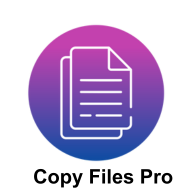
Here’s how it transforms your file workflows:
- Automatically sync files across items, boards, and columns
Whether it’s a campaign replicated across departments or a task transitioning from one phase to another, Copy Files Pro ensures all related files stay connected—without lifting a finger. - Copy or move attachments seamlessly when tasks are duplicated
Say goodbye to duplicate boards with missing documents. Every file follows its associated task, preserving the full context every time a workflow is reused. - Preserve file version integrity across the workspace
No more “final_v4” confusion. Maintain a clean, traceable version trail—even as items are copied or updated across multiple teams. - Enforce naming rules and folder logic—automatically
Set your structure once and let the app apply naming conventions and file organization every time. No more guesswork. No more chaos.
The result?
- One reliable file trail across your entire monday.com setup
- Fewer errors and misplaced documents
- More time for actual work—less time spent managing attachments
Copy Files Pro brings order to the disarray and empowers teams to scale their projects confidently.
No more hunting. No more re-uploading.
Just smooth, structured, automated file management—exactly where you need it.
FAQs on File Chaos in Project Tools
1. Can I automatically move or copy files when duplicating items in monday.com?
By default, monday.com does not carry over files when duplicating items or boards. However, with Copy Files Pro, files can be automatically copied or moved along with the item, preserving context and eliminating manual re-uploads.
2. How does Copy Files Pro help with version control in monday.com?
Copy Files Pro ensures that the latest version of a file is consistently synced across all relevant items and boards. This prevents confusion from multiple outdated copies and helps teams stay aligned with a single source of truth.
3. Does Copy Files Pro support both internal and external file structures like Google Drive or OneDrive?
Yes. Copy Files Pro works seamlessly with native file uploads as well as files linked through cloud platforms like Google Drive and OneDrive, allowing you to maintain folder logic, naming conventions, and secure access—all within your monday.com workflows.
In Conclusion: Eliminate File Chaos Before It Undermines Your Projects
Your team doesn’t need another place to store files. What you need is a systematic, scalable way to manage file flow—one that eliminates disorder at the root.
File chaos doesn’t stem from a lack of tools. It stems from a lack of structure.
Without deliberate, enforced systems, files get lost. Context disappears. Collaboration slows to a crawl.
To stay competitive and move with precision, your documentation must follow your workflows—not fight them. That means:
- A structure that ensures files move with the task
- A structure that minimizes ambiguity and enforces consistency
- A structure that scales effortlessly as your operations grow
Whether you build that structure through team-wide discipline or implement automation to drive consistency, the outcome must be non-negotiable:
Clarity. Control. Continuity.
Because when you trust your files, you trust your process—and when your process is sound, your team delivers. Every time..

He is the founder of CloudVandana and is an 8X Salesforce Certified Professional dedicated to crafting custom Salesforce solutions for businesses worldwide. His deep expertise ensures seamless digital transformation and scalable growth for global enterprises.
cloudvandana.com ->Salesforce Experts and IT Services
Appexchange apps
monday.com apps

